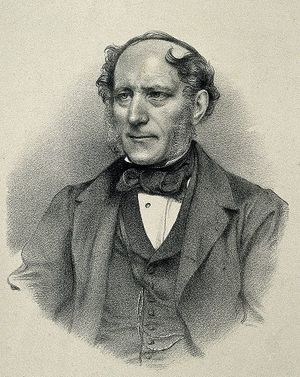Joseph Barnard Davis
Contents
Notes
Office Notes
ESL Council 1870-71 Member
ASL Council 1867 Vice President
ASL Council 1868 Vice President
ASL Council 1869 Vice President
ASL Council 1870 Vice President
ASL Council 1871 Vice President
LAS Council 1873 Member
LAS Council 1874 Vice President
LAS Council 1875 Vice President
AI Council 1871 Vice President
AI Council 1872 Member
AI Council 1875 Member
AI Council 1876 Member
AI Council 1877 Member
AI Council 1878 Member
AI Council 1879 Member
House Notes
anatomist; Foreign Associate of the Anthropological Society of Paris, corr. member of the Sociedad Antropologia Espanola, of the Academy of Natural Sciences of Philadelphia, dell' Accademia Reale di Medicina di Torino, and of the American Ethnological Society
Report of Council for 1881. Obit
Notes From Elsewhere
Joseph Barnard Davis (1801–1881) was an English medical doctor now remembered as a collector and craniologist.
In the summer of 1820, while still a student, he went as a surgeon in a whaling ship to the Arctic seas. Obtaining the Apothecaries' Hall qualification in 1823, it was not till twenty years later that he became a member of the College of Surgeons. In 1862 he graduated M.D. at the University of St Andrews. He early settled at Shelton, Staffordshire, and was a medical practitioner till his death on 19 May 1881. He was elected a Fellow of the Royal Society in 1868.
In 1836 he published a Popular Manual of the Art of Preserving Health.[1]
Davis collected a museum of skulls and skeletons of various races, nearly all with histories;[1] it was larger than all the collections in British public museums put together, numbering 1474 in 1867.[2] His personal collection began with two skulls bought from Matthew Moorhouse in 1848.[3] He purchased from the collection of James De Ville (Deville), a phrenologist.[4] He corresponded with travellers, collectors, and residents in foreign countries. In 1856 he began with John Thurnam, the publication of Crania Britannica: delineations and descriptions of the skulls of the aboriginal and early inhabitants of the British islands, with text, plates and an accompanying atlas. The work was completed in 1865. In 1867 he published a catalogue called Thesaurus Craniorum, describing and figuring many specimens, and giving 25,000 measurements. In 1875 a supplement to the Thesaurus was published. In 1879 or 1880 the Royal College of Surgeons purchased the collection, then numbering 1800 crania and some skeletons.[1][5]
As well as his collection of human remains, Davis was an avid collector of books, photographs, prints, drawings and artefacts relating to many cultural groups. Amongst his collection were works of art and artefacts collected originally by George Augustus Robinson from Tasmania and from the state of Victoria, Australia. The Australian works were mainly purchased by Davis after Robinson’s death from Robinson’s widow.[6] Davis also bought art works relating to Tasmanian Aborigines directly from the artist John Skinner Prout.[7] Davis’s collection was dispersed after his death through a series of auctions in London at Sotheby’s in 1883. Many works relating to Oceania, Asia, the Americas and Africa were purchased by A W Franks and given to the British Museum in the late 1880s and 1890s.[8][9]
Davis was a critic of the idea of human speciation. He believed that comparative anatomy would demonstrate that racial differences were immutable.[10] He supported anti-evolutionary views, and presented a paper to the British Association for the Advancement of Science in 1868, on brain weight,[11] publishing Contributions towards Determining the Weight of the Brain in Different Races of Man (Philosophical Transactions, 1868, clviii. 505–28). In an 1869 paper On the Weight of the Brain in the Negro he argued that brain weight was a racial character.[12]
A polygenist, he drew conclusions on the intellectual capacities of the Australian Aborigines, in particular, from his collection.[13] A motivation for his collecting was his belief that the morphology of the Australian remains provided indications of a separate origin.[14]
For some years from 1870 he was one of the editors of the Journal of Anthropology, and of Anthropologia
Publications
External Publications
In 1836 he published a Popular Manual of the Art of Preserving Health
Crania Britannica: delineations and descriptions of the skulls of the aboriginal and early inhabitants of the British islands, with text, plates and an accompanying atlas. The work was completed in 1865.
In 1867 he published a catalogue called Thesaurus Craniorum
Contributions towards Determining the Weight of the Brain in Different Races of Man
On the Weight of the Brain in the Negro
On the osteology and peculiarities of the Tasmanians, a race of man recently become extinct 1874
House Publications
ESL
On the method of measurements, as a diagnostic means of distinguishing human races, adopted by Drs Scherzer and Schwarz in the Austrian circumnavigatory expedition of the Novara
ASL
on the Neanderthal skull Read 15 nov 1864
Description of the skeleton of an Aïno woman, and of three skulls of men of the same race
LAS
a description of three Siah Posh Kafir skulls
on the prehistoric antiquities of the Caucasus [by Dr Isidore Kopernicki translated by J. Barnard Davis]
AI
Notice of Some Recent Anatomical Writings Bearing Upon Anthropology, by Prof. Luigi Calori, of Bologna 1872
Related Material Details
RAI Material
MS 140-152 Notebooks
MS 436 Notebooks, letters and papers mostly dealing with Crania Britannica and a report on Australian Aborigines. 1853-1900
2 skull albums in Photograph Collection
Other Material
Bristol U., Natural History Museum, Auckland Central City Library [corresp.]; RCS: large and magnificent collection of skeletons and skulls [W.H. Flower's action noted in Presidential Address 1900]
